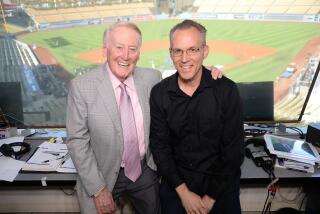In 1962, Dodger Stadium lacked a key liquid asset
When Dodger Stadium opened 49 years ago, historian Kevin Starr observed, it was “state of the art,” from its “column-free construction” and “unobstructed view of home plate from every seat” to its “escalators serving four levels” and “comfortable seats for fans.”
There was just one problem, he noted: There were no drinking fountains.
Well, actually there were two, one in each team’s dugout. But, of course, the fans in the 56,000-seat ballpark were not allowed to get in line with the players when they needed a sip.
One ticket-holder at the April 10, 1962, opener complained afterward to The Times that when she asked a Dodgers employee where she could get a drink of water, she was told she was welcome to use any of the taps in the ladies’ rooms.
Which prompted Times columnist Jim Murray to quip: “You can, to be sure, drink direct from the tap. All you have to do is hang by your heels from the water pipes like a sloth. This way, you get more exercise than the left fielder.”
The Dodgers, Murray added, “might also have pointed out that there is plenty of water under the ground if the patrons would only take the trouble to drill for it.”
In the ensuing hubbub, City Councilman Edward Roybal pointed out that Los Angeles Memorial Coliseum had 150 drinking fountains and the Sports Arena had 48. He suggested that Dodger Stadium’s water shortage might have been an attempt “to facilitate beer sales.”
If so, Roybal asked, what about children and other nondrinkers? (This was, older fans will recall, long before folks started carrying around store-bought water bottles.)
Plumbing historians were reminded of the 1955 opening of Disneyland, which also was devoid of drinking fountains.
Founder Walt Disney denied charges that he was trying to ramp up soft-drink sales and explained he had been hampered by a plumbers strike. It was a matter of building either restrooms or drinking fountains and he chose restrooms, Disney said in a memorable turn of phrase, because “people can buy Pepsi Cola but they can’t pee in the street.”
As for the Dodgers, owner Walter O’Malley, a man known for being tight with a buck, also denied a conspiracy and said the lack of fountains was an oversight.
A team spokesman declared there were 221 cold-water faucets in the stadium and announced that the team had purchased Dixie cups to set out in the restrooms. The cups were color-coded to match the hues of the stadium’s different levels.
The Dodgers, however, struck out with the ultimate umpire in this dispute: the city Health Department. Putting drinking facilities in restrooms was a health violation, the agency said, and the team was ordered to install an “adequate” number of drinking fountains in spectator areas.
Years later, O’Malley groused to sportscaster Gil Stratton, “We still have 300,000 color-coded Dixie cups in a storeroom somewhere in the stadium.”
O’Malley, who died in 1979, was also less than contrite in a 1977 interview with broadcaster Vin Scully. O’Malley recalled being kidded about the controversy by the manager of the old Statler Hotel on Wilshire Boulevard during a tour.
“We went past five bars,” O’Malley recalled. “I said, ‘Show me your drinking fountains.’ He didn’t have a single one.”
Ironically, back in 1962, Dodger Stadium’s original building plan had called for the construction of a giant cascading fountain behind center field with spotlights that would be activated whenever a Dodger hit a home run.
But that idea was abandoned — a wise move, perhaps, considering the lack of fountains. Thirsty fans might have felt compelled to dip into the fountain for a drink.
The Dodgers’ 2011 home opener was Thursday. Since it was a 90-degree day, it seemed a good time to check back on the water situation in Chavez Ravine.
The team’s website lists 14 Dodger-blue water fountains, offering 40 drinking stations. Even so, a thirsty reporter had difficulty finding two of the fountains because they were hidden behind a Budweiser stand and a “gluten-free” food stand, respectively.
Of 16 other stations tested on the Loge and Reserve levels, six either were inoperative or emitted only a trickle. Have the Dodgers been paying their water bills?
The stadium’s concession areas did offer an alternative, of course: bottles of water priced at $4.50 and $5.75.
One was reminded of the old joke that the reason Dodgers fans started the custom of leaving games around the seventh inning was not to beat the traffic. It was to search for water.
More to Read
Sign up for Essential California
The most important California stories and recommendations in your inbox every morning.
You may occasionally receive promotional content from the Los Angeles Times.










